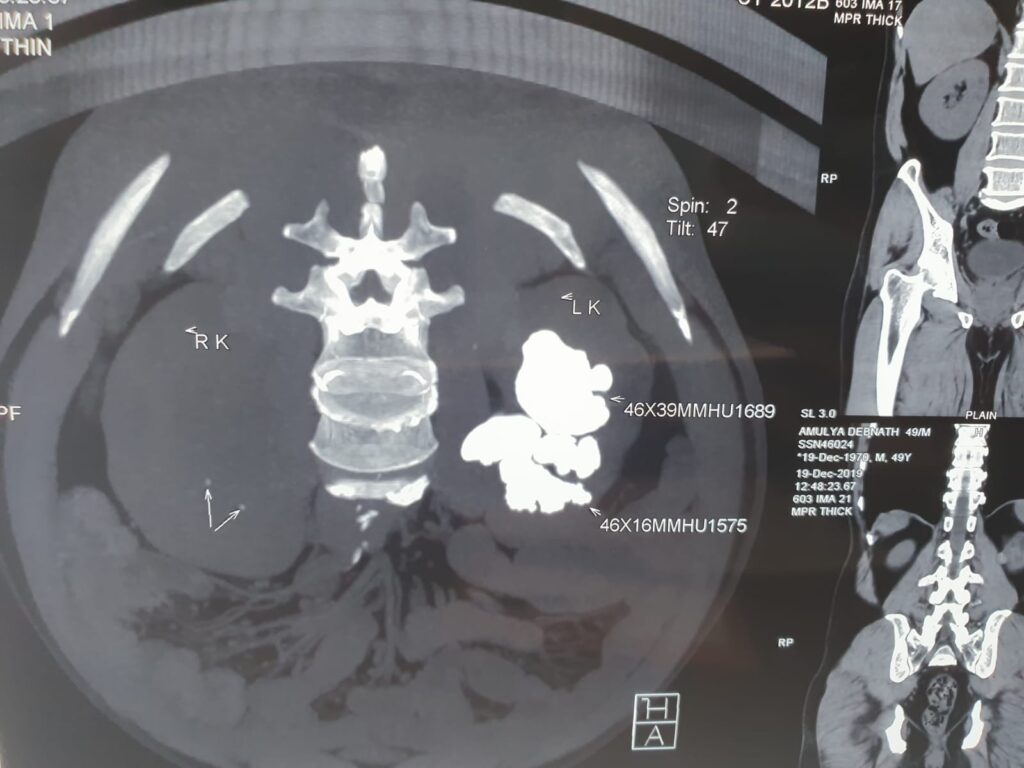


ENDOSCOPIC COMBINED INTRARENAL SURGERY
Endourological treatment modalities for kidney stones include extracorporeal shock wave lithotripsy (ESWL), flexible ureteroscopy (FURS), and percutaneous nephrolithotomy (PCNL). Percutaneous nephrolithotomy (PCNL) is still the gold-standard treatment for large and/or complex renal stones. Evolution in the endoscopic instrumentation and innovation in the surgical skills improved its success rate and reduced perioperative morbidity. Traditionally, PCNL is performed in the prone position as it allows a direct access to kidney with theoretically lesser risk of colon injury.
Advantages of Supine PCNL over Prone PCNL.
- Lesser operative time
- Less morbidity relating to anaesthesia as airways are not compromised in the prone position
- More suitable for obese persons
- Easier access to multiple calyces
- Bladder fistula
- Lesser bleeding
However, for complex renal stones, the residual stone after PCNL is very common, and the treatment is a tenacious business. Complex stone situations, such as renal stag-horn calculi, often necessitate several access points and multiple stage procedures. With the recent advances in endoscopic technology, FURS has become a more efficient and safer treatment of stones throughout all renal calyces compared with ESWL and PCNL. However, it is difficult to clear all the stones from each renal calyx using single technical equipment in some cases.
Evolution of ECIRS
A potential technique, which is called endoscopic combined intrarenal surgery (ECIRS), is a practical option for the treatment of complex renal calculi. ECIRS is a combined rigid and flexible antegrade and retrograde approach for the treatment of large and/or complex urolithiasis, usually performed in the Galdakao-modified supine Valdivia (GMSV) position.
It simultaneously combines FURS and PCNL to explore renal cavities and aims at the one-access resolution of urolithiasis along the whole urinary tract. The major advantage of using simultaneous antegrade-retrograde therapy for complex renal calculi is the better stone-free rates. ECIRS is especially convenient for the treatment of post-PCNL residual stone fragments.
Benefits of ECIRS
- ECIRS represents a safe, effective and comprehensive approach to PCNL.
- ECIRS allows versatile personalized stone management.
- Ureteric catheter placement and puncture for PCNL can be done simultaneously.
- Migrated fragments into the lower ureter during PCNL can be retrieved without having to change position unlike in prone PCNL.
- Impacted upper ureteric stone which is difficult to access antegrade during PCNL can be pushed into the kidney by ureteroscope at the same time.
- RIRS can be performed simultaneously on the opposite side.
- In case of calyceal stone, RIRS can be done to guide the calyx to be punctured in order to avoid parallel calyx entry.
- A small residual fragment in an inaccessible calyx during supine PCNL can be relocated or removed by RIRS avoiding additional puncture.
- Allows inspection of all calyces to ensure stone clearance during PCNL, which is particularly useful to radiolucent stones.
- Average surgical time is less compared to PCNL.
- The stone-free rate is significantly higher than that of other procedures.
- The decrease in hemoglobin during ECRIS is significantly lower than other procedures.
- The use of flexible endoscopes during ECIRS contributes to minimizing radiation exposure, hemorrhagic risk and post-PCNL renal damage.
GIVE US A CALL
+91 7338882290
Send us a Message
On WhatsApp
VISIT OUR LOCATION
175, Big Street, Triplicane, Chennai